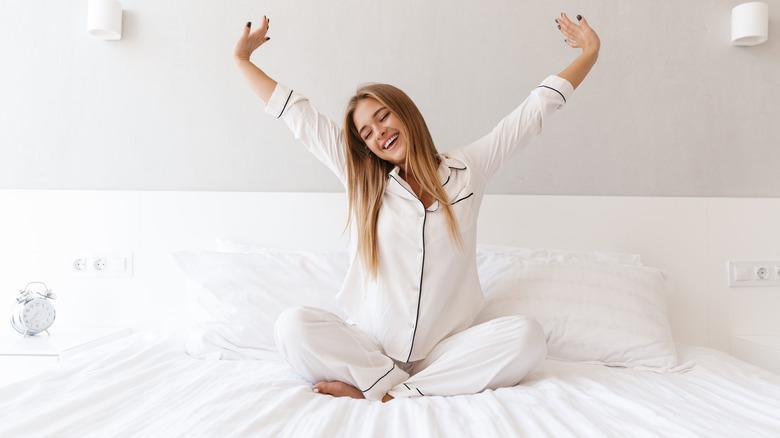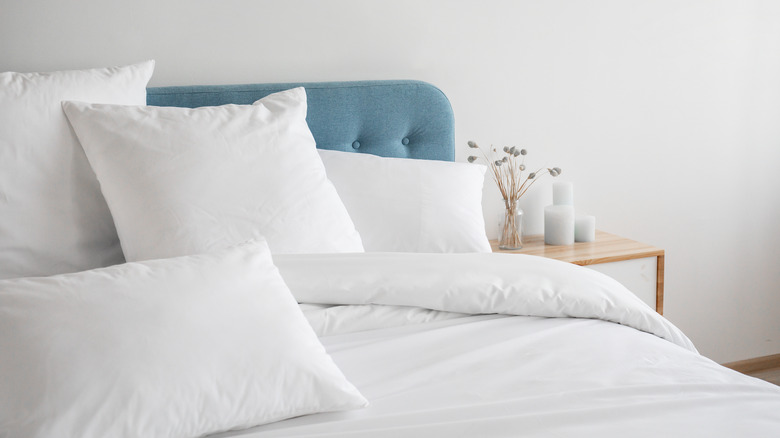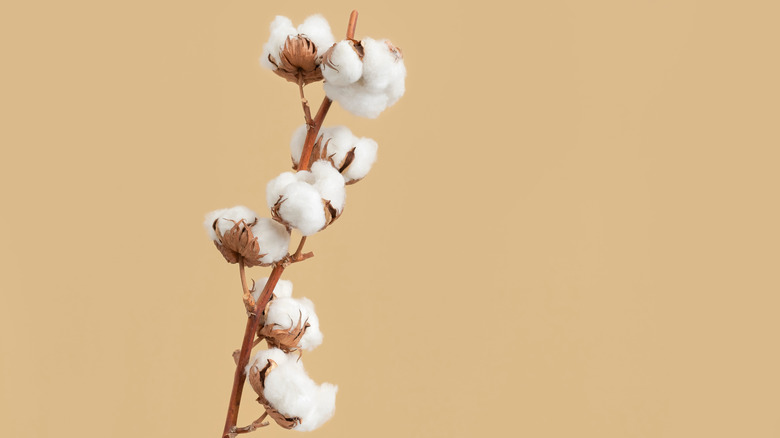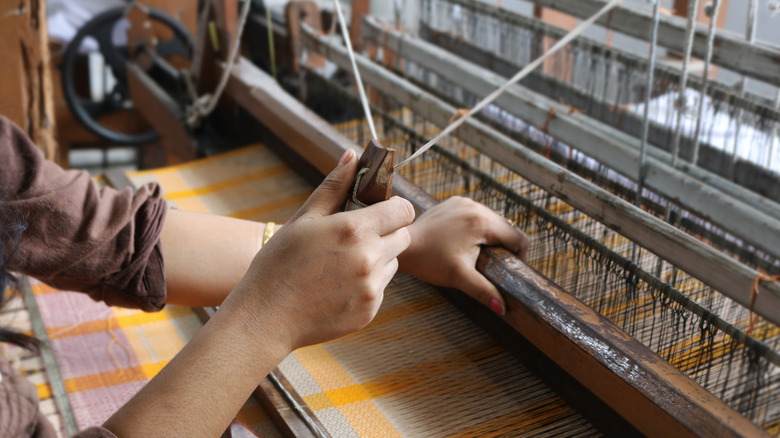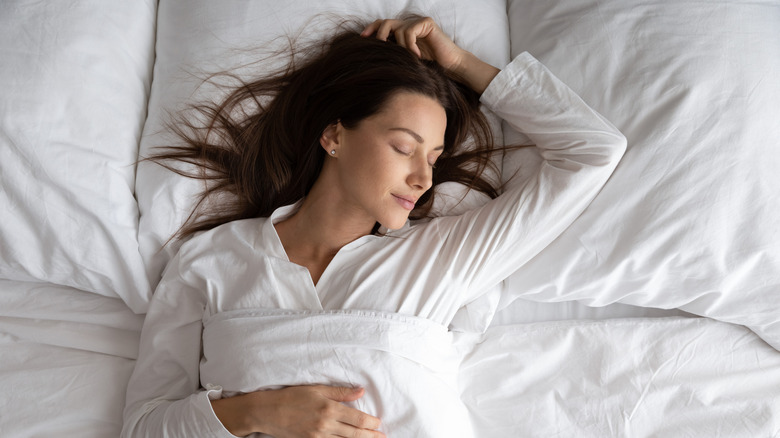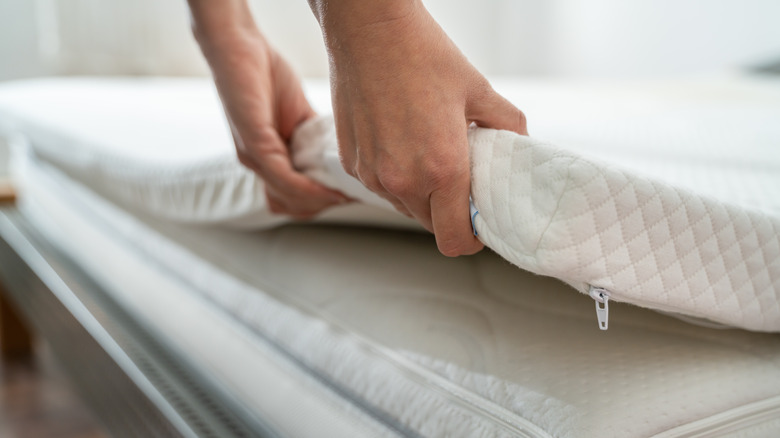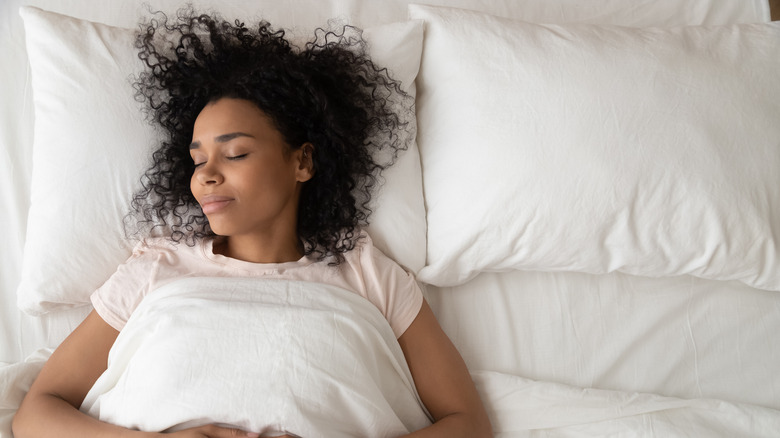Sheets: Everything You Need To Know Before You Buy
Considering the fact that we all spend a significant percentage of our lives in bed, high-quality bedding is a smart investment. Bedsheets are an essential component of every bedroom, but choosing the right set when you need to replace them can quickly become overwhelming. The right set of sheets feels great against your skin, keeps you cool throughout the night, and lasts for years, according to Good Housekeeping.
Unfortunately, shoppers are faced with choices about material, weave, size, and thread count, and bombarded with marketing terms like "organic," "long-staple," "sateen," and "deep-pocket" that only add to the confusion. On top of all this, there's really no single set of sheets that's right for everyone. While some people are looking for sheets that feel lightweight and crisp, others want them to feel silky and luxurious. This guide will break down everything you need to know before you buy a new set of sheets, including information on materials, weave, and more, as well as what you should expect to pay based on the fabric.
Natural vs. synthetic
When choosing a material for sheets, shoppers must first choose between natural and synthetic fibers.
Generally speaking, sheets made with natural fibers are considered higher quality and tend to be breathable, comfortable, and durable. The downside is that they come with a higher price tag. Some of the most popular natural fibers are cotton, linen, tencel, and silk, according to The Spruce. Cotton is the most popular material for sheets because of its softness, durability, and easy maintenance. It does vary widely in quality, from affordable Upland cotton to pricey Supima cotton. Linen is derived from flax plants and gets softer with every use. It's naturally hypoallergenic and moisture-wicking, ensuring a comfortable sleep even in hot weather, but it wrinkles easily, making for a more casual look. Tencel is a natural and eco-friendly option that's made from wood pulp, and tends to be more affordable than other natural fabrics but not as breathable, so it's not ideal for hot sleepers. Silk sheets feel ultra-luxurious but are pricey and difficult to care for.
Synthetic fabrics are affordable and readily available. Some of the most popular synthetic materials for sheets include polyester, microfiber, and nylon. Polyester is a popular synthetic fabric that can be treated in many different ways and goes by various names. The term microfiber refers to tightly-woven polyester. They're durable and stain-resistant but aren't particularly breathable. Acrylic sheets are very wrinkle-resistant but can feel somewhat rough against the skin. They also tend to pill. Sheets labeled as bamboo are technically made from a natural material, but most sheets on the market labeled as bamboo are actually made from rayon. While they aren't particularly eco-friendly, this style of sheets does come close to replicating cotton in its feel and durability.
Types of cotton
If you choose to shop for cotton sheets, there are still several decisions to make regarding the individual threads.
Cotton made from long fibers—also called long-staple cotton — is largely considered to be the best option available. Vicki Fulop, who co-founded bedding brand Brooklinen, told HuffPost, "In the case of cotton, a longer staple is a better staple. Longer cotton fibers can be spun into stronger, finer yarns and produce extremely smooth and supple weaves. Shorter fibers can poke out of the weave, leading to a coarser, weaker fabric." Wirecutter explains any cotton fiber which is approximately 1⅛ to 1¼ inches long is considered a long-staple fiber while extra-long staple fibers measure 1⅜ inches or longer.
Types of long-staple cotton include certified Egyptian cotton, Pima cotton, and Supima cotton. However, some brands will simply throw the word "Egyptian cotton" into their marketing without actually having anything to back it up. Therefore, it's important to be wary of anything labeled as Egyptian cotton that doesn't come from a reputable brand. One way to guarantee quality is by looking for sheets labeled as being made from Supima cotton. The Supima council has verified these products as being made from Pima cotton grown in the United States.
You may also want to consider purchasing organic cotton. While this won't impact the quality of the sheets, it means that the cotton crops were grown without the use of pesticides. Unfortunately, cotton is very prone to pests, and long-staple cotton is tough to grow without the use of any chemicals. Some cotton is bleached or treated with potentially harmful chemicals during the manufacturing process. To avoid sheets processed with these chemicals, look for a certification from the Global Organic Textile Certification (GOTS) or Oeko-Tex.
Choosing between weaves
Rachel Cohen, co-founder and co-CEO of Snowe, tells Apartment Therapy that the way sheets are constructed is just as important as the materials used. She said, "Think of it as the perfect meal: The ingredients are just as important as the cooking, and the same goes for bedding." There are three primary weaving methods used for creating sheets: percale, sateen, and jersey, all of which offer different advantages. The ultimate decision between the three, however, is simply a matter of preference.
Percale weave sheets feel light and crisp, like a freshly-starched shirt. Sheets with a percale weave have a matte look and may feel somewhat rougher against the skin. This effect is achieved with a "one-over-one-under" weave style that may also be referred to as "plain weave." According to Sleepopolis, percale sheets feel cooler and are typically more breathable. They may be a great choice for use in summer or for those living in warmer climates. Percale sheets are, however, more prone to wrinkling than those made using other weave styles. Because they're so crisp, they may also make a crinkling sound when you roll over.
Sateen weave sheets use a "three-over-one-under" style instead to achieve a smoother, softer material. They have a distinctive sheen that makes them look silky and luxurious. They aren't quite as breathable as percale sheets and are slightly warmer, making them a good year-round option. They're relatively wrinkle-resistant, but they are prone to pulls and pilling.
Jersey is a common cotton construction that's often found in clothing. Jersey sheets are a warm, cozy option that's perfect for wintertime. Jersey sheets have a more casual look, according to Sleepopolis, making them a good choice for children's bedding. Technically, jersey fabric isn't actually woven — it's knitted.
Thread count
When sheet shopping, be aware of the material's thread count. Thread count is determined by counting the number of vertical and horizontal threads in a square inch of fabric. Generally speaking, it's understood that a higher thread count results in softer, more luxurious feeling sheets. However, it turns out that a high thread count isn't necessarily an indicator of quality. The quality of the fibers themselves is far more important. Rachel Cohen explains to Apartment Therapy, "If you have poor-quality raw materials and manufacturing, a high thread count won't save you," adding, "conversely, if you have amazing materials, then a low thread count doesn't necessarily mean it's not a superior product." For example, sheets made from linen inherently have lower thread counts because each individual fiber is thicker. The weave style is also relevant: Sateen weave sheets have a higher thread count than percale weave sheets.
If you're opting for percale sheets, look for options with a thread count of between 200 and 500. For sateen, a number between 300 and 600 will be sufficient. Cohen adds that ultra-high thread counts may actually be an indicator of low-quality material, saying, "High-quality cotton threads cannot effectively get much higher than that; if you do see it, it's likely poor-quality threads jammed together." It's also important to consider whether the threads themselves are single-ply or multi-ply. While multi-ply may be the superior option for something like toilet paper, single-ply sheets are actually the highest quality pick. Vicky Fulop told HuffPost, "[Single-ply yarn] can only be spun from long-staple cotton, and results in light, soft, yet extremely long-lasting sheets." She adds, "Multi-ply yarns are a group of weaker fibers twisted together to create a false strength. They use mostly lower-grade, shorter-staple cottons, which result in thicker, coarser and heavier threads."
Sheet size
It would be easy to assume that choosing the right size of sheets would be easy. Simply get queen-sized sheets for a queen-sized bed ... right? While it's true that mattress sizes are standardized when it comes to their surface area, with a queen-sized mattress, for example, measuring 60 by 80 inches, the major way in which mattresses differ is in their depth, according to Casper. Like mattresses, sheets come in standard sizes to correspond with the mattress size. A fitted sheet for a queen-sized mattress measures 60 by 80 inches, while a flat sheet measures 96 by 102 inches.
Before you buy a new set of sheets, however, it's important to measure the depth of your mattress to ensure that the fitted sheet will adequately cover it. Mattress depths vary widely, and mattress toppers only add an additional variable. Be sure to include the depth of any toppers you use in the total figure. Standard fitted sheets have depths of approximately 12 inches, but if your mattress is larger than that, you'll need to look for deep-pocket sheets, which can accommodate depths of up to 18 inches. Since many sheet sets only include standard fitted sheets, those with very thick mattresses may have to consider buying their fitted sheets separately.
How much do sheets cost?
One factor that impacts the cost of sheets is how they're sold. While buying sheets individually is possible, purchasing a set is often more economical. Some sets include a flat sheet, fitted sheet, and matching pillowcases, while others also include a duvet cover.
According to Wirecutter, linen sheets are one of the priciest options, with an entry-level set for a queen-sized bed starting at $250 and going as high as $400 or more. Sheets made from 100%cotton with a percale or sateen weave cost between $50 and $150 for a queen-sized set. Expect to pay around $150 for a set of heavier flannel sheets. On the less expensive end, Wirecutter says that while it is possible to buy a sheet set for under $50, most options in this price category will either be rougher or won't have very good longevity and will need to be replaced more frequently.
It's best to have two sets of bed sheets for each bed in your home so you can rotate them when they're being laundered. To get the most out of your sheets, it's important to be mindful of how you wash them. CNN recommends washing sheets in cold water using the normal cycle. Senior scientist for Procter & Gamble Jessica Zinna says that using cold water has several benefits, telling CNN, "Switching to a cold water wash is not only beneficial for your clothes and your wallet but for the environment, too." She adds, "Up to 90% of the energy used during the laundry process goes towards heating the wash water for warm or hot cycles."
